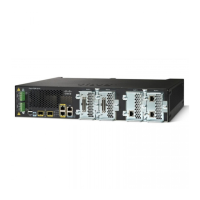31-84
Catalyst 3550 Multilayer Switch Software Configuration Guide
78-11194-09
Chapter 31 Configuring IP Unicast Routing
Configuring Protocol-Independent Features
Enabling PBR
By default, PBR is disabled on the switch. To enable PBR, you must create a route map that specifies
the match criteria and the resulting action if all of the match clauses are met. Then, you must enable PBR
for that route map on an interface. All packets arriving on the specified interface matching the match
clauses will be subject to PBR.
Beginning in privileged EXEC mode, follow these steps to configure PBR:
Command Purpose
Step 1
configure terminal Enter global configuration mode.
Step 2
route-map map-tag [permit | deny] [sequence number] Define any route maps used to control where packets are
output and enter route-map configuration mode.
map-tag—A meaningful name for the route map. The ip
policy route-map interface configuration command uses
this name to reference the route map. Multiple route maps
might share the same map tag name.
(Optional) If permit is specified and the match criteria are
met for this route map, the route is policy-routed as
controlled by the set actions. If deny is specified, the route
is not policy-routed.
sequence number (Optional)— Number that shows the
position of a new route map in the list of route maps
already configured with the same name.
Step 3
match ip address {access-list-number |
access-list-name} [...access-list-number |
...access-list-name]
Match the source and destination IP address that is
permitted by one or more standard or extended access
lists.
If you do not specify a match command, the route map
applies to all packets.
Step 4
set ip next-hop ip-address [...ip-address] Specify the action to take on the packets that match the
criteria. Set next hop to which to route the packet (the next
hop must be adjacent).
Step 5
interface interface-id Enter interface configuration mode, and specify the
interface to configure.
Step 6
ip policy route-map map-tag Enable PBR on a Layer 3 interface, and identify the route
map to use. You can configure only one route map on an
interface. However, you can have multiple route map
entries with different sequence numbers. These entries are
evaluated in sequence number order until the first match.
If there is no match, packets are routed as usual.
Step 7
ip route-cache policy (Optional) Enable fast-switching PBR. You must first
enable PBR before enabling fast-switching PBR.
Step 8
exit Return to global configuration mode.
Step 9
ip local policy route-map map-tag (Optional) Enable local PBR to perform policy-based
routing on packets originating at the switch. This applies
to packets generated by the switch and not to incoming
packets.

